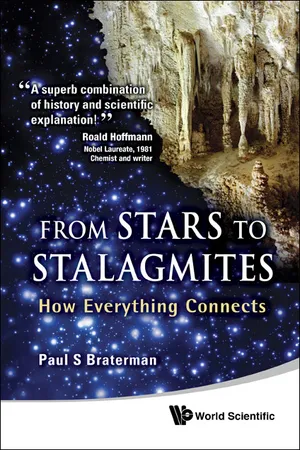
This is a test
- 328 pages
- English
- PDF
- Available on iOS & Android
eBook - PDF
From Stars To Stalagmites: How Everything Connects
Book details
Table of contents
Citations
Frequently asked questions
At the moment all of our mobile-responsive ePub books are available to download via the app. Most of our PDFs are also available to download and we're working on making the final remaining ones downloadable now. Learn more here.
Both plans give you full access to the library and all of Perlego’s features. The only differences are the price and subscription period: With the annual plan you’ll save around 30% compared to 12 months on the monthly plan.
We are an online textbook subscription service, where you can get access to an entire online library for less than the price of a single book per month. With over 1 million books across 1000+ topics, we’ve got you covered! Learn more here.
Look out for the read-aloud symbol on your next book to see if you can listen to it. The read-aloud tool reads text aloud for you, highlighting the text as it is being read. You can pause it, speed it up and slow it down. Learn more here.
Yes, you can access From Stars To Stalagmites: How Everything Connects by Paul S Braterman in PDF and/or ePUB format, as well as other popular books in Biological Sciences & Science General. We have over one million books available in our catalogue for you to explore.
Information
Table of contents
- Contents
- Acknowledgements
- Introduction
- 1. The Age of the Earth — An Age-Old Question Who thought what and when, and why
- 2. Atoms Old and New From Democritus to Rutherford
- 3. The Banker Who Lost His Head Lavoisier, gunpowder, revolution, and the birth of modern chemistry
- 4. From Particles to Molecules, with A Note On Homoeopathy Dalton, Avogadro, Cannizzaro; why did it take so long for the penny to drop?
- 5. The Discovery of the Noble Gases — What’s so New About Neon? A tiny difference in density leads to a whole new group of elements
- 6. Science, War, and Morality; The Tragedy of Fritz Haber Ammonia, explosives, fertiliser, gas warfare, and the most unintended of consequences
- 7. The Ozone Hole Story — A Mystery with Three Suspects Volcano, refrigerator, or jet plane?
- 8. Rain Gauge, Thermometer, Calendar, Warning What a stalagmite tells us about climate past; what history tells us about climate future
- 9. Making Metal Iron from the sky. Philistines and Phoenicians. Domestic uses of arsenic. Eros in Piccadilly. The jet age
- 10. In Praise of Uncertainty Unavoidable, and a good thing too
- 11. Everything is Fuzzy And the smaller, the fuzzier. Waves are particles. Particles are waves. Crisis in the atom
- 12. Why Things Have Shapes Lewis’s magic cubes. Stealing, sharing, double counting. The power of repulsion
- 13. Why Grass is Green or Why Our Blood is Red An old question answered. From sunlight to sugar. A brief history of colour vision. Blood and iron
- 14. Why Water is Weird Fragile bonds. Floating ice and foreign policy. Molecular recognition and the molecules of life
- 15. The Sun, The Earth, The Greenhouse Yellow-hot sun, infrared-warm Earth. When it comes to carbon dioxide, more is more. Disinformation and denialism
- 16. In The Beginning From Big Bang to small planet. The birth and death of stars. Size matters. The making of the elements. Vital dust
- Endnotes
- Glossary
- Index